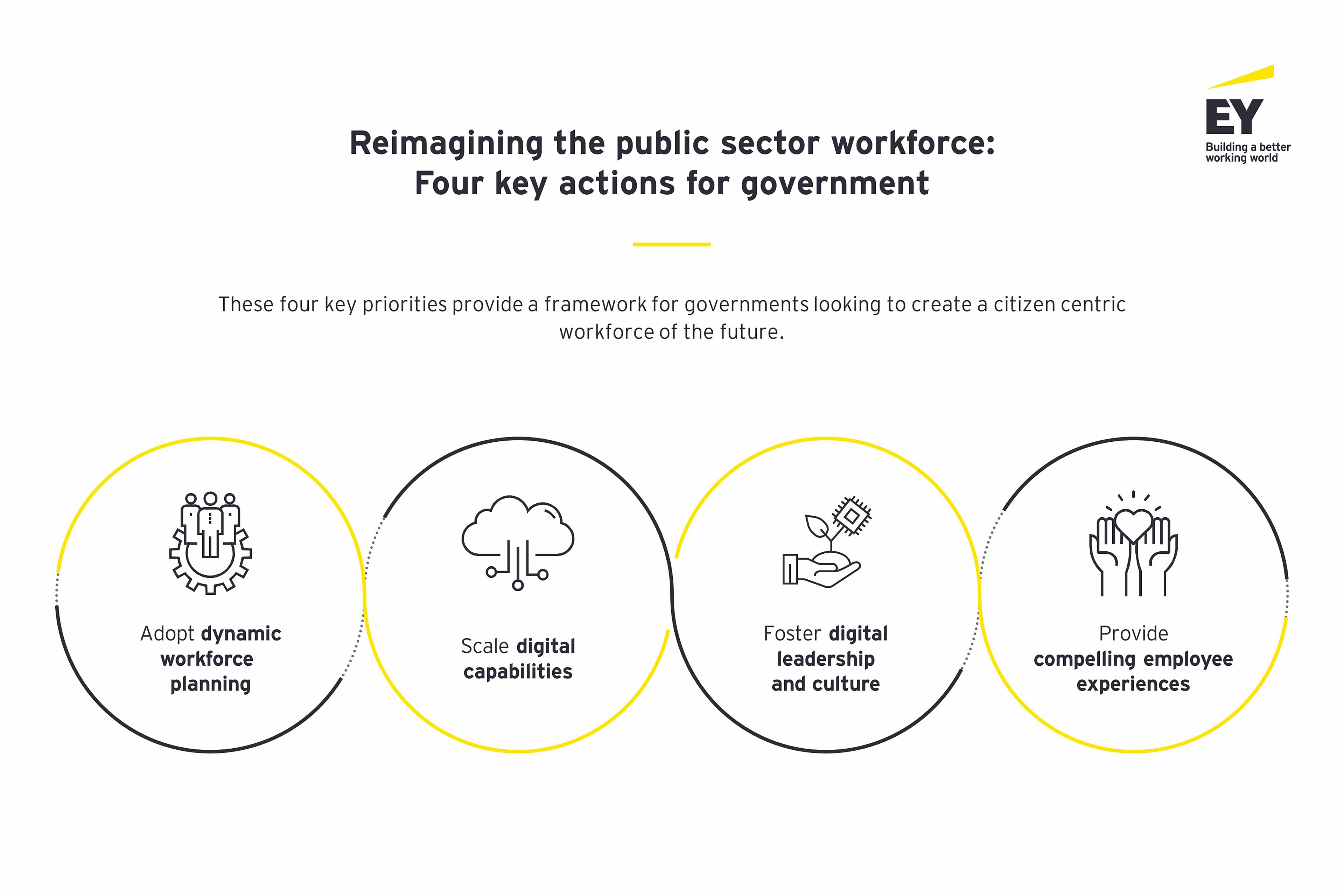
Chapter 1
A new generation of digital leaders in government
Leaders play a vital role in building an innovative, data-driven workplace culture.
Cultivating the new digital leader
A cross-industry EY study, conducted with the University of Oxford’s Saïd Business School, found that leaders identify leadership as the number one driver of successful transformation, but only 10th when it underperforms. Workers rank leadership as number one regardless.
The public sector is in urgent need of a new breed of digitally aware leaders, backed by senior executive sponsors who are actively committed to transformation.
A dedicated executive —sitting on the senior management board — should be appointed to lead the transformation program, working closely with the talent leader to align the digital and workforce strategy. They will use future-back planning to identify bold new opportunities, and craft a vision that enthuses and inspires all employees at all levels. In the EY-Saïd Business School study, 49% of respondents in high-performing transformations say the vision is clear and compelling versus just 27% of those in low-performing transformations.
Often, the digital director or chief information officer is not on the senior management board. In fact, it's almost unheard of. I find that extraordinary.
Being a digital leader requires the courage to challenge entrenched behaviors and mindsets, and the influence to build consensus. This calls for soft skills, such as emotional intelligence and a willingness to listen, as well as technical skills. The Singapore government, for instance, has drawn up a new Core Competency Framework, reflecting the more diverse capabilities that leaders need at different levels.
Leaders need the humility to acknowledge that they may not have all the answers, and a willingness to look for solutions both inside and outside the organization. Forty-seven percent of the survey respondents from high-performing transformations say their leaders welcome ideas from more junior personnel, versus 29% from low-performing transformations.
For digital leaders, the ability to drive change is as important as technical expertise. They need to keep a constant eye on citizens’ needs and the problems that need solving, while motivating staff to embrace creativity and continuous learning. The digital leader should also work with the talent leader to highlight how technology is successfully addressing society’s big challenges, which can inspire existing and future employees.
Our recent paper EY outlines 5 Leadership Mindsets (via ey.com UK), and recommends that leaders continually challenge themselves to ensure their beliefs, attitudes and values move with the times.
To find out more about the new breed of leader, read the full version of the paper.
Managing the change
Technical specialists may implement digital transformation, but it can’t happen without the wholehearted acceptance of the workforce, who need to embrace new digital tools and learn how to use data effectively. An effective digital transformation plan will consider all aspects of how the proposed changes will affect the workforce and what engagement is needed to build buy-in.
Many employees question their ability to work with technology and fear it may replace their jobs. However, the evidence is to the contrary: fewer than one in 10 leaders taking part in our EY 2022 Tech Horizon Survey reduced workforce numbers during digital transformation. As Amanda Cattermole, CEO, Australian Digital Health Agency, said, "5, 10 years ago, everyone was saying, ‘We're going to see a smaller knowledge-based workforce.’ I'm not so sure now. We're going to need people in different ways."
It’s the leader’s responsibility to paint a positive picture of change, communicating how it can enhance everybody’s jobs and deliver better services to citizens.
You have to show them “what's in it for me”. Why would I want to use this technology? ... It's about communication and proactive, ongoing training and handholding folks through the change process.
Cultural change also proceeds more smoothly when people take an active role, hence the importance of co-design. According to our EY 2022 Tech Horizon Survey, 64% of transformations that “exceed expectations extensively” engaged employees in designing the new employee experience; for initiatives that fell short, just 32% of people were involved actively.
Another successful change tactic is to create “digital champions” to help people understand and embrace new technology. Training can also accelerate buy-in, possibly augmented by incentives linking digital adoption to performance evaluations and even promotion. In the London Borough of Barking and Dagenham, digital champions have helped fellow workers co-design an analytics platform and shape the associated training.
Employee feedback helps to continuously improve the performance of technology. This doesn’t just raise motivation, it also encourages risk-taking, assuring workers that failure is a natural part of the creative process rather than something to be feared.
Abandoning caution and embracing a growth mindset
Creative new approaches to working practices and service delivery can only come through experimentation. However, public sector workers often struggle with change, fearful that failure will reflect badly upon them, with 58% of government leaders surveyed admitting they have not managed to instill a “fail-fast” mentality among staff.
Fail-fast mentality
58%of government leaders agree “our organization has tried introducing a fail-fast mentality, but our people are scared to embrace it.”
The COVID-19 pandemic proved that new, digital approaches to service delivery can dramatically enhance the citizen experience; it’s essential to maintain this momentum. Government leaders need to champion a culture where curiosity and questioning of the status quo is the norm, create a safe environment for experimentation and learning, and reward people for bold new ideas. The Canadian government, for example, offers prizes to stimulate new solutions for major public challenges, via the Smart Cities Challenge, the Drug Checking Technology Challenge and the Indigenous Homes Innovation Challenge.
One of the main goals I have in my team is to embrace every innovative mind and every project that makes us better. I can’t pay them more, so I have to … make them shine in other ways.
To embed entrepreneurial behavior, innovation labs, incubators, accelerators and internal hackathons or “skunkworks” (groups of people who research and develop a project for the sake of innovation in technology) can provide a safe environment for exploration and learning.
Key questions to consider
- Has leadership developed a clear and compelling vision that the whole workforce buys in to?
- How could we combine humans and technology to work in smarter ways?
- How can we educate and reassure our employees about the adoption of new technologies?
- How do we nurture a fail-fast mindset?

Chapter 2
Rethinking the employee experience
Attract and retain talent by offering purposeful, varied and exciting career opportunities.
A stage for fulfilling work
All organizations acknowledge the war for talent — especially for in-demand digital capabilities. Leaders responding to our EY 2022 Tech Horizon Survey say that retaining existing talent is one of the top-three barriers to acquiring essential digital and tech-related skills. Overcoming these barriers is arguably the top priority for government leaders.
We place people at the center of digital transformation because in the end, our people will execute all of this. Everything in the company is made with the employee journey in mind.
Government leaders say the struggle to retain existing talent is among the top-three barriers to obtaining the digital and tech-related skills their organization needs.
A crucial way to tackle this challenge — and to attract new talent — is to provide an outstanding employee experience (EX). An integrated talent management strategy takes a holistic view of the entire employee lifecycle and seeks to continually improve the experience over time.
Keeping track of employee sentiment via surveys can gauge job satisfaction, wellbeing and attitudes to learning, providing insights to design better experiences. Frequent pulse surveys offer more up-to-date feedback and enable ongoing two-way communications.
Public services such as health care, education, public safety and infrastructure play a vital societal role, and leaders can build on this to cultivate a sense of shared purpose that bind together a diverse workforce of permanent and gig workers of different generations and across different locations. Measuring and communicating the impact can reinforce the meaning of work and build pride.
We try to make sure we've got high-quality data and visualization systems to show our staff how effective they are being and what differences they are making.
Managing the new hybrid workplace
As hybrid working becomes mainstream, public sector organizations need to embed flexible working policies. As work-life boundaries blur, communications and management styles should adapt to support workers, avoid burnout, and balance wellbeing and productivity.
Hybrid working also presents an opportunity to repurpose office space — including desk sharing and collaboration hubs. The Canadian government has piloted the GCcoworking initiative, which provides shared workplaces for use by multiple departments, organized into different areas, including a “quiet zone” for focused individual working and an “interactive zone” for collaboration.
Of course, ultimately, hybrid working must fit within service delivery mandates, which means some roles will remain on-site. Equity between those working remotely and those obliged to be present in the workplace needs to be carefully maintained, in order to avoid a “two-tier” workforce where those in the office have access to more opportunities due to closer proximity to leadership. The EY 2022 Work Reimagined Survey reveals that 45% of government employees surveyed believe new ways of working will see some segments of the workforce losing out.
Two-tier workforce
45%of government employees surveyed believe new ways of working will cause some segments of the workforce to lose out.
Continuous learning and structured career paths
Continuous learning can contribute greatly to the EX, boosting employee satisfaction, productivity, retention and recruitment. Employees can receive funding and time off to attend courses, and access digital and on-the-job learning resources, while rewards and recognition programs can further incentivize learning uptake. Our EY 2022 Tech Horizon Survey shows that around one-quarter of government leaders surveyed consider incentives as one of the most important ways to build digital skills.
Learning will soon become the new dollar. More important in the value proposition for employees maybe even than their compensation and benefits.
Meanwhile, structured professional and career frameworks, underpinned by robust performance evaluation systems and merit-based promotions, will help workers feel they can fulfil their career ambitions. A professionalized public service would also allow for more individualized and flexible pay structures and terms of employment.
Key questions to consider
- How can we create a digital-driven, hybrid workplace?
- Do we offer the right mix of flexible working options?
- How do we ensure remote workers feel included and supported?
- How should we measure productivity and performance in a remote work environment?
- Do we offer a structured career path that enables people to achieve their ambitions?
- How can we monitor and respond to employee sentiment and maintain wellbeing?
Conclusion
The new digital leader is more an agent of change than a technical expert, painting a vivid picture of how technology can change citizens’ lives for the better — and revolutionize the workplace experience. With a mission to continually challenge the status quo, the leader will engage workers in the co-design of a new, hybrid working environment, where experimentation is commonplace, and failure an accepted part of innovation. Employees will enjoy varied careers, with continuous opportunities to learn and develop, and the satisfaction that comes from serving the public good.
Creating such an environment requires a very open and flexible approach to learning, using a full range of virtual and physical options, and making use of “digital champions” to push the agenda and help overcome resistance. Managing new, hybrid workforces will require fresh thinking and a more collaborative approach to management, with an increased emphasis on values and wellbeing, as well as opportunities to achieve professional digital qualifications. In this future workplace, the next generation of talent will have the opportunity to pursue a full range of exciting public sector careers.
Related articles
Summary
To inspire a tech-savvy, innovative workforce, public sector leaders should communicate a compelling vision of digital transformation that results in a better citizen experience. Getting there won’t be easy, and will require empathetic and inspiring leadership and change management. Future careers in government will be characterized by learning and experimentation, and a sense of pride and purpose in improving people’s lives.


